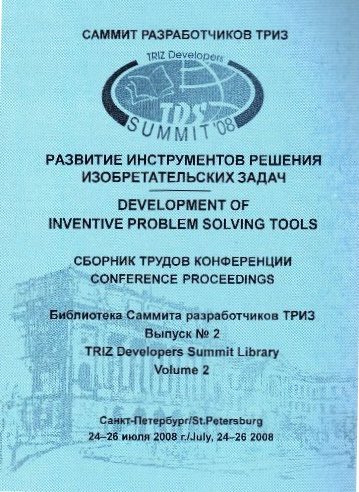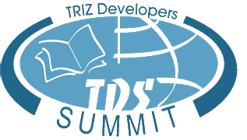
"Development of Inventive Problem Solving Tools"
Compiled by: A.V.Kudryavtsev, S.S.Litvin, V.M.Petrov, M.S.Rubin
Collection of scientific publications. Library of TRIZ Developers Summit. Issue 2, Saint Petersburg, 2008, 370 pages.
|
TABLE OF CONTENTS |
|
|
Introduction |
|
|
Welcome speech from representative of Saint Petersburg Polytechnical University |
|
|
|
|
|
Tools for Inventive Problem Solving on the Basis of Contradiction Resolution. |
|
|
A.Kudryavtsev "Tools for Inventive Problem Solving on the basis of Contradiction Resolution – Analysis and Directions for Further Development" The paper discusses main problems solved nowadays through the use of classical TRIZ methodological support for problem solving process. Besides, a brief review of papers submitted for TRIZ Summit-2008 is given and directions for further development of methodological support of this type are proposed.
G.Ivanov "Algorithm for Engineering Problem Solving – ARIP 2008" The paper proposes a new approach to the analysis of inventive situations and sequence of actions enabling to upgrade the degree of algorithmization of problem analysis process.
A.Noniashvili "Resolution of Engineering Contradictions Using Notions of Operative Zone and Operation Time" The paper proposes a simple mechanism for resolving engineering contradictions that is based on approaches implemented in ARIZ-91 and supplemented with a notion of element suggested by Sobolev in the "element-by-element" analysis.
A.Bushuyev "Vector Analysis of Resources" The paper deals with the search for new directions for the development of methodological tools. For the analysis of resources and elimination of contradiction the author proposes to employ a universal Physical Effect Classification Table (suggested by Bartini).
Rikho Viyk "Application of Regulatory Steps in Exploration and Classification of Techniques for Eliminating Engineering Contradictions" The author proposes a new approach for classifying techniques, which is based on Control Theory Principles and Fractal approach.
A.Tokarev "Alternative System of Contradiction Elimination Techniques" The author proposes a new approach for classifying contradiction elimination techniques, which is based on functional approach and construction of morphological matrices.
A.Revenkov, E.Rezchikova "Contradictions in Engineering Problems" The paper deals with the analysis of logical foundations, on which notions of engineering and physical contradictions are based. The authors also propose to upgrade the conceptual infrastructure.
G.Kizevich "Two Paradoxes and Four Strategies of ARIZ" The paper deals with the analysis of internal mechanisms employed in ARIZ-85C. The author gives suggestions of further improvement of ARIZ-85C operation mechanisms.
M.Rubin "Essays on Paradigm Changing in ARIZ Evolution". The author gives the analysis of current state of things with ARIZ and proposes a set of recommendations of further development of algorithms for inventive problem solving.
E.Kurgi "Analysis of Engineering Contradictions: Key Steps and Perspectives of Development" The author proposes a complex approach to procedures for engineering contradiction resolution, including employment of resources from high-level supersystems.
| |
|
|
|
|
Tools for Inventive Problem Solving on the Basis of Su-Field Models. | |
|
V.Petrov "System of Generalized Models" The paper describes a system of generalized models that could be used for analyzing existing systems, synthesizing and forecasting new systems and solving standard inventive problems. The system of models includes standards for inventive problem solving, system evolution trends and contradiction resolution principles. | |
|
M.Rubin "Representing Su-Fields as Matrices" The author proposes to present Su-fields and Su-field transformation in the form of matrices. This approach enables to extend the possibilities of Su-field analysis and application of mathematical methods for matrix computation. | |
|
Yu.Murashkovskiy "Application of Standards Depending on Superproblems. Possibilities for Supplementing a System of Standards by Analogy with Non-Engineering Systems". The paper describes a two-parameter scale "resource – object of changes" intended for determining a level of changes in a system. The author shows that the majority of standards of System-76 are intended for changing average levels. Certain standard changes characteristic of non-engineering systems are identified. The author demonstrates that it is possible in principle to transfer such standard changes into engineering systems. | |
|
|
|
|
Tools for Inventive Problem Solving on the Basis of Function Model. | |
|
S.Litvin Function-Oriented Search (FOS) |
|
|
N.Feygenson "Function-Oriented Information Search (FOIS) - history, potentialities, restrictions, and suggestions on efficiency enhancement". The author describes the history of creation and application of Function-Oriented Information Search (FOIS) and analyzes the publications on this issue. Besides, the author presents the analysis of FOIS efficiency for the development and substantiation of concepts in consulting projects and identifies restrictions on FOIS application when improving certain classes of engineering systems. Recommendations are given on refinement of parametric requirements when formulating tasks for FOIS and new format for describing proven engineering solutions from "leading" branches is proposed.
| |
|
A.Pinyaev "Elementary Functional Transformations when Solving Inventive Problems Using Functional Prompts Method" The paper describes a new approach to generating solution options for an inventive problem by means of basic functional transformations of the functional model of the problem. These transformations include changes of the subject, object or action of a function in a certain way such as segmentation of the object or compensation for the action. The suggested approach leads to a simpler and easier process for obtaining functional solutions of a problem, increases the number of the promising inventive solutions and reduces time required for idea generation within TRIZ-based project. | |
|
A. Pinyaev "Method for Analyzing Elementary Functional Transformations when Solving Inventive Problems Using Functional Clues Method" The article describes a new method for inventive problem analysis and solving, which includes the why-why analysis (i.e. cause-effect analysis) of an initial technical challenge, building a comprehensive Why-Why Contradiction Map, function analysis of high-level contradictions in the Map and resolving these contradictions by means of the system of Functional Clues. The proposed method uses and develops well-known TRIZ techniques such as why-why and functional analyses. It also uses a new problem-solving tool – a system of Functional Clues. The proposed method is used in problem solving process and innovation training at Procter and Gamble Company, USA.
| |
|
V.Petrov "Functional Approach" This paper briefly described the "Functional approach" proposed by the author. The author considers function analysis of existing systems and functional synthesis of new systems. Special attention is given to functional synthesis. | |
|
M.Rubin "Multi-Aspect Function-Oriented Search (FOS)"
The paper deals with methods for creating a function model as applied to function-oriented search (FOS) and its application in non-engineering fields of knowledge.
| |
|
A.Efimov "Extending the Frames of Problem to Raise the Probability of Successful problem Solving". Goals of specific project may appear to be objectively unattainable due to objective and subjective constraints. The author proposes and briefly describes two main directions enabling to raise the probability of successful project performance by extending the area, in which search for solution is conducted. | |
|
A.Smirnov, E.Sokolov "Automated FOS System" The paper describes a developed software product "Algo AS FOS" (Automated System for Function-Oriented Search). The search is conducted for action that is identical or very close in terms of result to the one carried out in the initial standard FOS block [Subject - Function - Object]. An option of practical implementation of this technology is demonstrated. | |
|
S.Pernitskiy "Multi-Functionality as a Tool for Invnetive Problem Solving" This paper contains a review of approaches for enhancing multi-functionality of engineering systems. After conducting analysis of examples of multi-functional solutions, the author identified types of multi-functionality and proposed a classification for them. In addition, the authors also identified ways for attaining multi-functionality that could be used for solving inventive problems. | |
|
|
|
|
Tools for Inventive Problem Solving on the Basis of Trends of Engineering System Evolution (TESE). | |
|
V.Petrov, M.Rubin Systems of Trends of Engineering System Evolution. Analutical Review. The paper briefly describes the history of evolution, main problems and directions of evolution of TESE systems. The authors also present a short review of publications on TESE submitted for TRIZ Summit-2008.
| |
|
V.Petrov. "Innovation Technology". This paper offers a brief review of foundations of developed methodology called Innovation Technology. It is based on classical theory of inventive problem solving - TRIZ. Innovation Technology represents a system approach to improvement of existing systems and synthesis of new systems.
| |
|
A.Kynin, V.Lenyashin. "System-Based Consideration of Engineering System Evolution"
Inventors always wanted to forecast the evolution of one or another Engineering Systems (ES). Trends of Engineering System Evolution (TESE) represent tools for such forecasting. These trends are the foundation of the Theory of Inventive Problems Solving (TRIZ). G. Altshuller published the main ideas of TESE in 1975. The most important part of TESE is dependence between evolution of product performance and product lifetime. This dependence is called curve of life stages or S-curve. The goal of this paper is systemize and classify the life stages curves for different Engineering Systems. Application of proposed classification enables to forecast the future evolution of systems.
| |
|
A.Efimov "Analysis of Evolution According to S-Curve: Goals and Main Principles".
The author formulates main problems related to the analysis (in real projects) of engineering system evolution according to S-curve. The author also gives suggestions on solving identified problems owing to refinement of goals and tasks of this analysis and major steps of analysis performance. | |
|
O.Abramov "Trends of Engineering System Evolution in Information Processing and Transmission Systems" Attempts to employ TESE analysis to modern engineering systems (ES) for information transmission and processing (e.g., to telecommunication ES or to software products) systems are often unsuccessful due to difficulties. There is an opinion that classical TRIZ is unsuitable for analyzing such ES. This paper is an attempt to show on examples that many known TESE (if not all known TESE) are valid for ES for information transmission and processing. | |
|
M.Rubin "Creation of Theory for Designing Innovation-Technological Systems" The author proposes approaches to creation of a theory for designing innovation-technological systems (ITS). This theory considers inventions and business as a single process. Notions of multi-aspect approach, functional-targeted system and system "tissue" are proposed for designing innovation-technological systems. | |
|
|
|
|
History of TRIZ Development and Contents of TRIZ as a Science |
|
|
V.Petrov "Brief History of TRIZ Development". The paper presents main milestones and events during TRIZ development and evolution. | |
|
S.Litvin, V.Petrov, M.Rubin "TRIZ Body of Knowledge" As a topic for discussion, the authors propose a list of key TRIZ subdisciplines that represent the foundation of TRIZ as a science and list of published references to these subdisciplines. | |
|
S.Litvin, A.Lyubomirskiy, I.Sigalovskaya "Glossary to G3:ID Methodology" The paper gives glossary for TRIZ-based G3:ID methodology that is used by GEN3 Partners and Innovation Center "Algorithm" in practical work of innovation-technology consulting and in training employees of large companies in USA, Europe and Russia. | |
|
Table of Contents | |
|
Index of authors | |
|
Annotated Table of Contents (in English) | |
